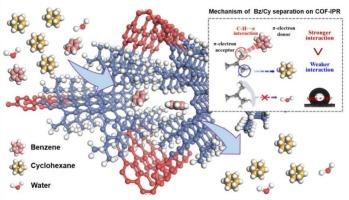共价有机骨架中脂肪族通道的构建及苯和环己烷的高效分离
IF 13.2
1区 工程技术
Q1 ENGINEERING, CHEMICAL
引用次数: 0
摘要
从环己烷中分离苯是一项重大挑战,因为它们的沸点和分子大小相似,使得传统的蒸馏和通过分子筛的吸附分离方法无效。通过与苯和环己烷具有明显分子相互作用的吸附剂进行选择性分离可能是一种潜在的解决方案。因此,本研究设计了一种具有富含异丙基的脂肪通道的新型共价有机框架(COF-IPR),通过C-H⋯π相互作用将苯从环己烷中分离出来。COF-IPR在苯/环己烷(298 K和12.5 kPa)浓度为50 %:50 %时的IAST选择性为30.1,与现有的最佳材料HFPB-TAB-COF(36.0)和Zn-TCNQ-bpy(29.9)相当。COF-IPR也表现出2.8的突破分离因子,比领先的cof,即JUC-641(1.9)和hppb - tab - cof(1.9)提高了47.4 %。COF-IPR与苯(而非环己烷)的C-H⋯π相互作用通过傅里叶变换红外(FT-IR)、拉曼光谱、Hirshfeld表面分析和DFT计算的组合来阐明。此外,COF-IPR是一种疏水材料,水接触角高达135°,即使在99% %的相对湿度下也能确保出色的苯/环己烷分离性能。此外,COF-IPR在高达380 °C的温度下表现出强大的热稳定性,在pH范围为1至13的溶液中表现出水/化学稳定性。本文章由计算机程序翻译,如有差异,请以英文原文为准。

Construction of aliphatic channels in covalent organic framework for efficient separation of benzene and cyclohexane
Separation of benzene from cyclohexane is a significant challenge due to their similar boiling points and molecular sizes, rendering conventional methods like distillation and adsorption separation via molecular sieving ineffective. Selective separation by adsorbents having distinct molecular interaction with benzene and cyclohexane could be a potential solution. Therefore, a novel covalent organic framework (COF-IPR) with aliphatic channels enriched by isopropyl groups was designed in this study to separate benzene from cyclohexane via C-H⋯π interactions. COF-IPR achieves an impressive IAST selectivity of 30.1 at 50 %:50 % of benzene/cyclohexane (298 K and 12.5 kPa), comparable to the best available materials like HFPB-TAB-COF (36.0) and Zn-TCNQ-bpy (29.9). COF-IPR also exhibits a breakthrough separation factor of 2.8, a 47.4 % enhancement over the leading COFs, i.e., JUC-641 (1.9) and HFPB-TAB-COF (1.9). The C–H⋯π interactions of COF-IPR with benzene, but not cyclohexane, were elucidated through a combination of Fourier transform infrared (FT-IR), Raman spectra, Hirshfeld surface analysis and DFT calculations. Furthermore, COF-IPR is a hydrophobic material with water contact angle up to 135°, ensuring excellent benzene/cyclohexane separation performance even at 99 % relative humidity. Additionally, COF-IPR exhibits robust thermal stability up to 380 °C and water/chemical stability in solutions with pH ranging from 1 to 13.
求助全文
通过发布文献求助,成功后即可免费获取论文全文。
去求助
来源期刊

Chemical Engineering Journal
工程技术-工程:化工
CiteScore
21.70
自引率
9.30%
发文量
6781
审稿时长
2.4 months
期刊介绍:
The Chemical Engineering Journal is an international research journal that invites contributions of original and novel fundamental research. It aims to provide an international platform for presenting original fundamental research, interpretative reviews, and discussions on new developments in chemical engineering. The journal welcomes papers that describe novel theory and its practical application, as well as those that demonstrate the transfer of techniques from other disciplines. It also welcomes reports on carefully conducted experimental work that is soundly interpreted. The main focus of the journal is on original and rigorous research results that have broad significance. The Catalysis section within the Chemical Engineering Journal focuses specifically on Experimental and Theoretical studies in the fields of heterogeneous catalysis, molecular catalysis, and biocatalysis. These studies have industrial impact on various sectors such as chemicals, energy, materials, foods, healthcare, and environmental protection.
 求助内容:
求助内容: 应助结果提醒方式:
应助结果提醒方式:


